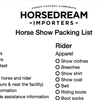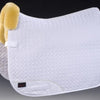The Reality Check: Why Expensive Anatomical Girths Are Failing
The equestrian community online has been brutally honest about their experiences with anatomical dressage girths, and the results might surprise you. After analyzing active discussions across r/equestrian and r/dressage and other communities, here's what riders are really saying about their expensive investments.
The $400+ Problem
One particularly revealing thread shows a rider who spent over $400 on a County Logic girth recommended by their saddle fitter, only to question whether they'd been "taken for a ride." The community's response was eye-opening: similar girths were available for $200-225. This sparked a heated discussion about whether premium pricing actually delivers premium results. But a closer look into the various experiences shows it's not so easy.
What's Actually Failing
Some of the more common complaints include:
- Neoprene padding getting "gross and hot"
- Synthetic materials breaking down over time as girths are heating up
- Horses rejecting girths due to temperature and no sweat able to evaporate
- Low-quality materials that feel rough and irritate sensitive horses causing chafing
- Patchwork construction with seams creating pressure points and hot spots
- Girths that can't be properly cleaned
- Bacterial buildup causing odors and transferring skin issues from horse to horse in many synthetic girths
Pressure point problems
Despite their anatomical design, shaped girths sometimes create uneven pressure distribution. As one saddle fitter noted in the discussions: "Even when I relieve pressure with new saddle and appropriate girthing options, the girthiness still happens" in lower quality girths.
Quality and Construction Issues
Beyond material problems, riders report construction and quality control issues with certain anatomical girths. Many discover they're paying premium prices for inferior sheepskin grades, patchwork construction with uncomfortable seams.
One particularly frustrating issue is girths that develop bacterial buildup and odors over time, requiring frequent replacement despite their high initial cost.
What Actually Works: Natural Materials
Interestingly, the girths that consistently work share common characteristics:
- Natural materials (especially sheepskin)
- Proper anatomical design that actually adapts to the horse
- Quality construction methods
- Better hygiene properties (washable!)
But what makes the difference between good sheepskin and great sheepskin? What construction details should you look for? We'll explore these crucial factors in our next article. (Hint: Not patched)
The Sheepskin Pattern
Multiple threads highlight sheepskin as a game-changer. One rider noted: "My girthy WB gelding is only happy in a sheepskin girth."
What This Means for Smart Shoppers
These online discussions reveal that expensive doesn't always mean effective. Riders are questioning premium prices and seeking genuine solutions based on natural materials and proper construction.
The community is increasingly sophisticated about what they're paying for, prioritizing genuine comfort and durability over brand recognition and marketing hype.
Before spending $400+ on an anatomical girth, understand what materials you're actually getting and whether the price reflects genuine quality or just brand markup.









